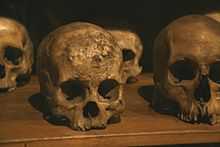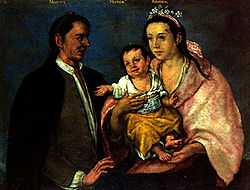Museo Nacional de Antropología (Madrid)
| National Museum of Anthropology | |
|---|---|
| Museo Nacional de Antropología | |
|
Museum's main facade | |
| Established | 1875 |
| Location | Madrid, Spain |
| Type | Archaeological and ethnographic |
| Public transit access | Atocha station |
| Website |
mnantropologia |
| National Museum of Anthropology | |
|---|---|
|
Native name Spanish: Museo Nacional de Antropología | |
 Location of National Museum of Anthropology in Spain | |
| Location | Madrid, Spain |
| Coordinates | 40°24′28″N 3°41′20″W / 40.407694°N 3.688975°WCoordinates: 40°24′28″N 3°41′20″W / 40.407694°N 3.688975°W |
| Official name: Museo Nacional de Antropología | |
| Type | Non-movable |
| Criteria | Monument |
| Designated | 1962[1] |
| Reference no. | RI-51-0001384 |
The National Museum of Anthropology (Spanish: Museo Nacional de Antropología) is a national museum of Spain, located in Madrid near the Parque del Buen Retiro and opposite Atocha railway and metro station. It is considered the oldest anthropology museum in Spain, formally inaugurated on April 29, 1875 during the reign of Alfonso XII.
History
Dr Pedro González de Velasco promoted his project of a museum of Anatomy and assembled the early collections. The focus later passed from physical to cultural anthropology.
Structure
Each of its three floors is dedicated to a different subject:

A collection of skulls from the beginnings of the museum.
- Ground floor. The Asia hall, devoting a special attention to the culture of the Philippines, a Spanish colony until 1898, with many items taken from an 1885 exposition in nearby Retiro Park. It also dedicates side rooms to temporary exhibitions and a Wunderkammer giving an impression of the early exhibitions including a Guanche mummy, a plaster cast and the skeleton of the "Extremaduran Giant" (Agustín Luengo Capilla), and statues and plaster casts of several racial types.
- First floor. The Africa hall, with a prominent representation of the culture of Equatorial Guinea, a Spanish colony until 1959.

A Peruvian example of pintura de castas ("caste pictures"), showing a Mestizo as the offspring of Mestizo parents.
- Second floor. The Americas hall, covering indigenous peoples of the Americas, with items like Jivaro reduced heads, Andean Carnival masks, and Inuit sun glasses.
A lecture hall allows performances of traditional music and dances and lectures.
References
External links
![]() Media related to Spanish National Museum of Anthropology at Wikimedia Commons
Media related to Spanish National Museum of Anthropology at Wikimedia Commons
_01.jpg)